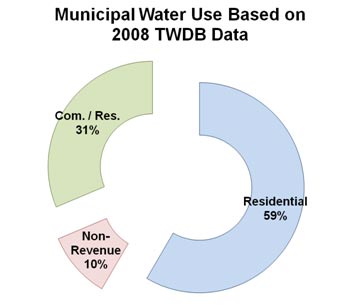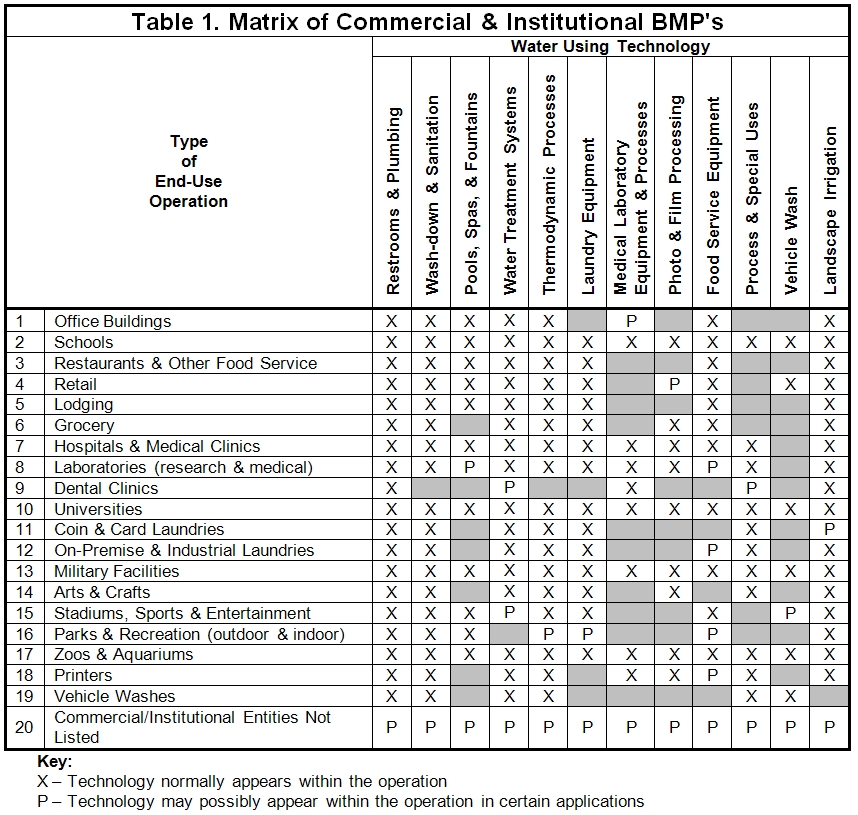Commercial & Institutional Workgroup
| Date | Agenda | Minutes | Related Documents |
|---|---|---|---|
| October 12, 2023 | Agenda | Minutes | |
| April 26, 2022 | Agenda | Minutes | |
| June 11, 2020 | Agenda | Minutes | |
| June 8, 2017 | Agenda | Minutes | DRAFT BMP Guide - May 2017 |
| December 2, 2015 | Agenda | Minutes | Draft BMP Guide |
| September 2, 2015 | Agenda | Minutes | |
| March 4, 2013 | Agenda | Minutes | BMPs for Commercial and Institutional Water Users 3/14/13 |
| June 18, 2012 | Agenda | Minutes | Hoffman Draft 5/28/12: ICI Best Management Practices |
| March 1, 2012 | Agenda | Minutes | State of California Draft: ICI Best Management Practices |
| October 24, 2011 | Agenda | Minutes |
|
The Water Conservation Advisory Council (Council) seeks to invite commercial and institutional stakeholders to participate in activities and discussions in the following areas:
- Evaluating and defining metrics for commercial and institutional water uses,
- Improving resource information such as developing commercial and institutional Best Management Practices (BMPs),
- Improving awareness and recognition for commercial and institutional water conservation, and
- Identifying case studies and trends in i commercial and institutional water conservation efforts
2008 Commercial and Institutional Water Use by Sector
The State of Texas does not specifically collect water use information for the commercial and institutional sectors. However, the 2008 estimated of per capital water use show total and residential (single and multi-family) water use for a number of Texas Cities. The difference between residential and total per capita use includes water use by the commercial and institutional sectors as well as non-revenue water. If it is assumed that ten percent of total per capita water use is non-revenue water, than the rest can be assumed to be commercial and institutional uses. The TWDB subtracts industrial use prior to making per capita water use estimates Based on the 565 Texas Cities that report both residential and total use, the population weighted total per capita use was 166 gallons per person per day (GPCD) and the residential per capital use was 97 gallons per person per day. If 10% of the total was non-revenue water, then commercial and institutional water used equaled 52 gallons per person per day or 31 percent of total municipal water use. Commercial and Institutional water use includes all non- industrial and non-residential water uses. Apartment water use is sometimes included in the commercial sector since these are businesses that just happen to provide customers (residents) with a residence. Here, apartment water use is included in residential water use.
 2008 Commercial and Institutional Water Use by Sector and Best Management Practices
2008 Commercial and Institutional Water Use by Sector and Best Management Practices
Commercial and Institutional water use includes all non- industrial and non-residential water uses. The amount of water used by each type of commercial and institutional water user and the way in which it is used is different. Table 1. provides examples of typical commercial and institutional water users and shows the water using technologies commonly employed by each. The goal of the Council is to establish ways to monitor water use by major sector and develop Best Management Practices for each of the water using technologies employed by these sector.

Evaluation of Water Use Metrics
The Council would like to host discussions with i commercial and institutional stakeholder groups in order to evaluate current metrics for measuring water use across various commercial and institutional types. To better understand commercial and institutional water use it is necessary to use consistent terminology and methodologies to compute water use data across various commercial and institutional users types.
One of the goals of this workgroup is to get various stakeholders involved in discussions on commercial and institutional water use to help define consistent parameters for water use metrics and encourage commercial and institutional water users to incorporate these metrics into their water conservation programs. Consistency in the application of metrics will allow for better understanding and reporting of water use which in turn will provide a measure by which water conservation successes can be understood and shared.
The Council has proposed that commercial and institutional water use metrics be based on a unit of production (UOP). That is, the number of gallons required to refine a barrel of crude oil, or the number of gallons required to generate a megawatt of electricity. The Council would like to engage stakeholders in developing metrics for various industrial sectors and encourage industrial water users to develop water conservation programs using these metrics.
Water Conservation Best Management Practices
The 2004 Texas Best Management Practices Guide currently includes commercial and institutional BMP's in the Municipal sector. This addresses these measures from a utility perspective. The Council has determined that this sector have its own stand alone BMP Guide chapter for use by both utilities and more importantly, the commercial and institutional users.
Public Awareness
A public awareness campaign that incorporates media, outreach, and resources for water users is a good first step to achieve a measure of success in water conservation. Lasting water conservation will be achieved through the involvement of every
in Texas by ensuring commercial and institutional water users take all possible steps to reduce water use. Commercial and institutional users should be encouraged to look closely at their water use by conducting water audits and identifying every opportunity to conserve water through increased efficiency and reduced waste. Stakeholder groups are invited to share information across their sector to educate and engage water users in the effort of conserving water for future generations.
How we plan to proceed:
- Develop a list of stakeholder organizations beginning with those groups with the greatest water use. For industry these initial outreach will focus on power generation, mining, and the refining, chemical, food and paper sectors of manufacturing. The initial contact will be through f trade associations but can later expand as interest and needs dictate.
- Establish communications with these groups asking their help in refining metrics, developing and revising BMPs, providing supporting case studies, documenting trends, and providing input to the Council efforts.
- Hold organized discussions, conference calls or webinars to host effective discussions about water conservation.